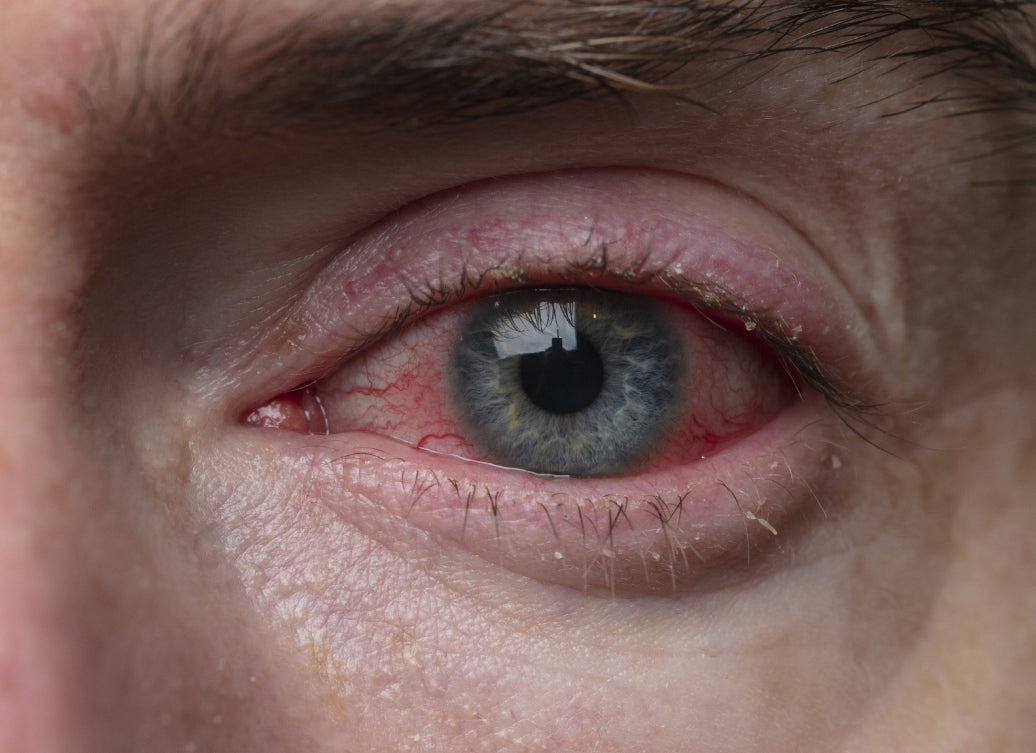In this blog we take a closer look at what causes blepharitis, an itchy and uncomfortable inflammatory condition which affects the eyelids.
What is blepharitis?
Blepharitis is a common inflammatory condition that affects the eyelids. It can cause itchiness and discomfort, but usually isn’t serious enough to cause lasting damage. Blepharitis isn’t infectious, so you can’t catch it or pass it on to someone else.
There are two slightly different types of blepharitis, which affect different parts of the eyelid: the first, anterior blepharitis, affects the skin at the root of your eyelashes. The second type, posterior blepharitis, affects the skin on the inner of the eyelid. This type is more likely to affect people with skin conditions.
What are the symptoms of blepharitis?
The main symptom of the condition is discomfort around the eyes. This discomfort can take a few different forms:
- Sore skin around the eyes
- Itchy eyelids
- Gritty feeling in the eyes
- Flaky or scaly skin around the eyelashes
- Crusts in the eyelashes
- Red eyes
- Inflamed or swollen skin around the eyes
- Eyelids sticking together when you first wake up
- Eyes watering
- Sensitivity to light
In more serious cases symptoms might also include:
- Blurred vision
- Eyelashes falling out
- Swollen corneas
What causes blepharitis?
Although the condition can be caused by a number of things, the main - most common - cause of blepharitis is an overgrowth of bacteria (is Staphylococci) in the eyelashes. It’s totally normal to have bacteria on the skin - everyone has it, and it’s found all over the body - but problems can arise when there’s too much bacteria in one place.
Skin conditions & blepharitis
As well as these bacteria, there’s also an association with chronic skin conditions such as
- rosacea
- eczema
- seborrheic dermatitis
These skin conditions can cause flaky, inflamed skin anywhere on the body, including the base of the eyelids. The problem with the eyelids is that they’re not so easily or regularly cleaned as other parts of the body, so dead skin cells can accumulate and block the oil glands of the eyelashes. Add to this a tendency towards inflammation and an impaired skin barrier, and you can see how blepharitis might be a real problem for those with chronic inflammatory skin conditions.
Even without a chronic skin condition, oil glands can be blocked by dead skin cells, mites, yeasts or bacteria, and cause the inflammation and itchiness of blepharitis.
The problem with Demodex
As well as bacterial overgrowth and blocked oil glands, blepharitis also has an association with a proliferation of tiny skin mites called Demodex in the eyelashes. Demodex are particularly associated with rosacea, and with people whose immune systems are compromised or lowered. One research paper suggests that various things can change the environment to make a proliferation of Demodex more likely: ‘sunlight exposure, alcohol intake, smoking, stress, hot beverages, spicy food, and abrupt changes in temperature’.
Demodex can cause inflammatory response by carrying bacteria into the skin, and Demodex proteins and debris can also trigger a hypersensitive immune system response, so they are problematic in all sorts of different ways!
Finally, blepharitis can be aggravated or triggered by allergies, hormonal imbalances and infections.
The reality is that the condition is likely to be both triggered and exacerbated by a complex interwoven set of circumstances and conditions; someone prone to seborrheic dermatitis might have a proliferation of yeasts or mites or bacteria on their skin, which has an impaired skin barrier, and oil glands that are prone to getting blocked by excess debris or skin cells. Their immune system response can affect how resilient they are to fighting off further flares of blepharitis. It certainly isn’t always as simple as a direct cause and effect.
What’s the treatment for blepharitis?
Although blepharitis isn’t something you can cure, it can be managed by making the eyelashes less likely to be overloaded with bacteria or Demodex, or for glands to get clogged.
The NHS website suggests that you keep your eyelids clean by washing them at least once a day, and avoid wearing contact lenses or makeup while you have symptoms. Use warm water, a very gentle cleanser (such as Balmonds Natural Shampoo & Body Wash) and clean cotton wool or cotton buds to do this. If symptoms don’t improve within a week, ask your doctor for eye drops.
If your eyes are very sore and dry, you can use Skin Salvation to ease the dryness around your eye. There’s also strong evidence to suggest that tea tree oil (diluted 50%) kills Demodex mites, and that massaging 5% tea tree ointment into eyelashes can prevent them from breeding, so you could try using Balmonds Tea Tree balm on your eyelids.
Recommended products:
Balmonds Natural Shampoo & Body Wash
with calendula & chamomile
Balmonds Skin Salvation
with hemp and beeswax
Balmonds Tea Tree Balm
balm with tea tree essential oil and beeswax
